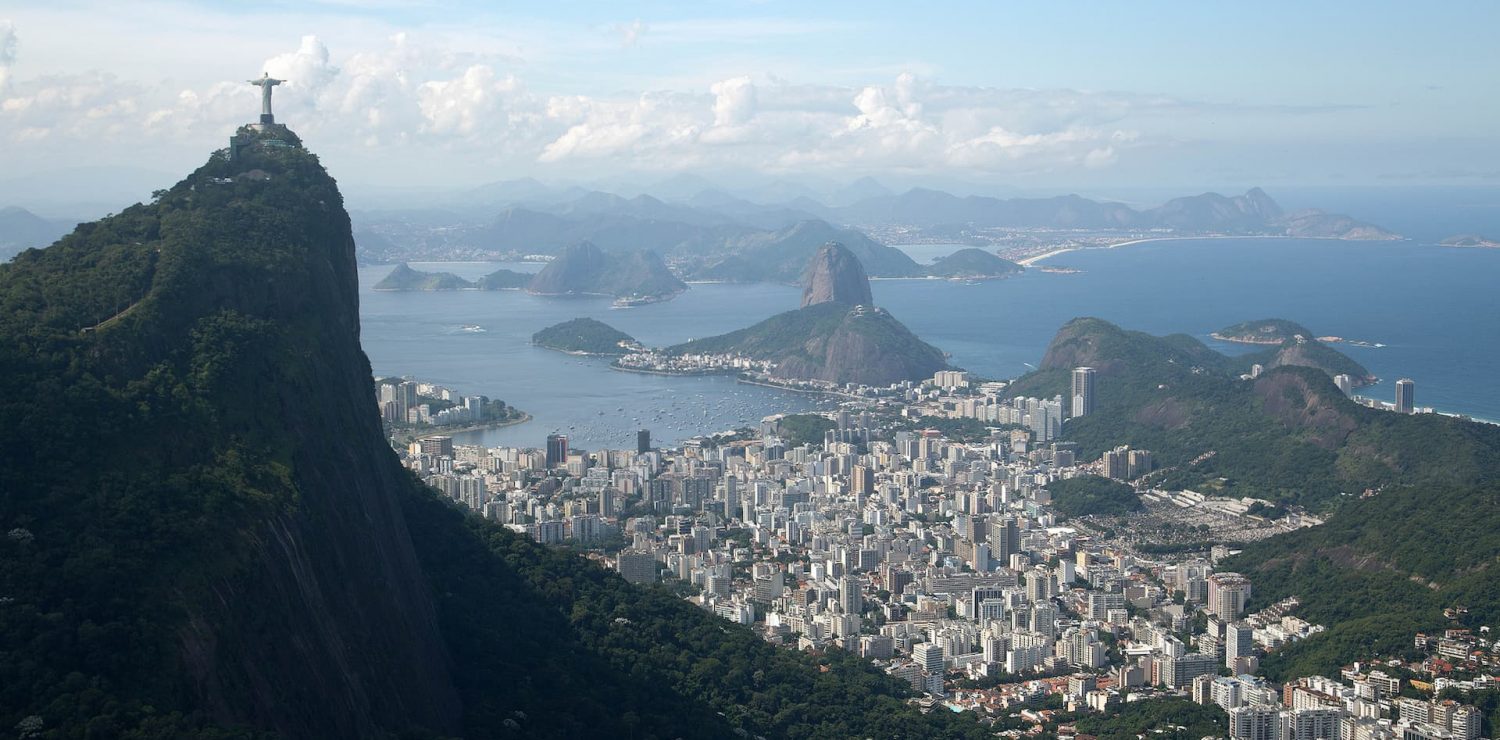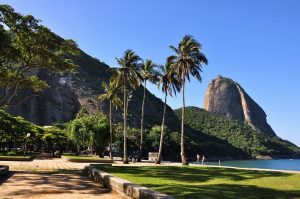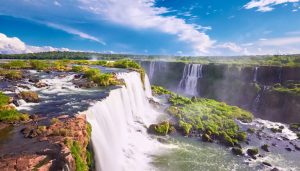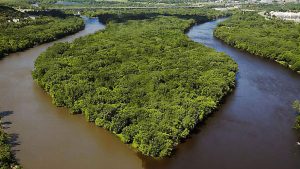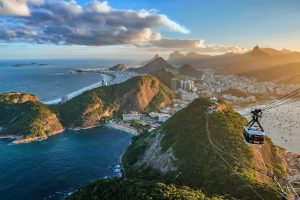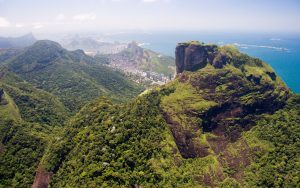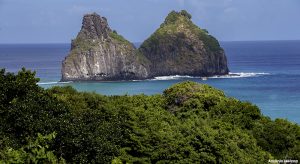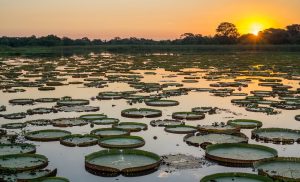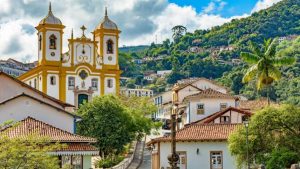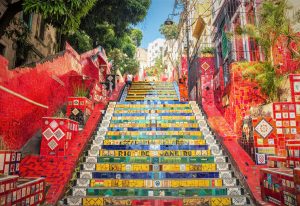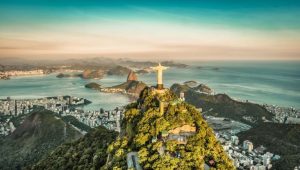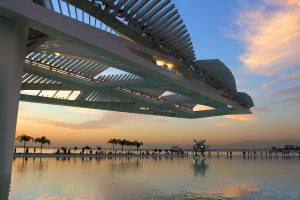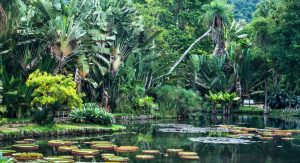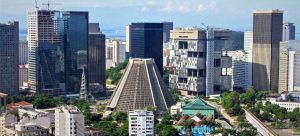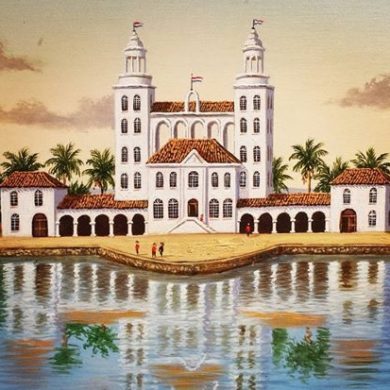Brazil boasts a wide array of landmarks, ranging from natural wonders to colonial cities and mountaintop statues. With continuously improving tourism infrastructure, it’s becoming easier to explore these unique sites. Travel Brazil Selection has been organizing luxury tours in Brazil for years, and we know it’s impossible to cover all the magnificent landmarks in one post. However, here are six must-see Brazilian landmarks that we think should be on your bucket list!
Brazilian landmarks : the must-see natural sites
Brazil is a country characterized by an absolutely captivating natural environment. From north to south, there are a multitude of different ecosystems, and landscapes as varied as they are magnificent. Sometimes it’s hard to choose what to see, as the country is so vast. That’s why we’ve selected a few landmarks not to be missed!
1. Iguazu Falls
Iguazu Falls, straddling the border of Brazil and Argentina, is one of the world’s most incredible natural wonders, a real landmark of the country ! The enormous cascades stretch for 2700 meters in width and range between 200 and 269 feet in height. Eleanor Roosevelt famously exclaimed, “My Poor Niagara!” when she visited, noting that Iguazu is about 100 feet taller and twice as wide as Niagara Falls. Most of the waterfalls are on the Argentinian side, providing a spectacular landscape view from Brazil and an up-close experience in Argentina. You can easily visit both sides from the Brazilian town of Foz do Iguaçu. Entrance fees to the parks are reasonable. Cross the border from Brazil to Argentina for a full or half-day tour. The best way to visit is by booking a full-day Iguazu Falls tour, which includes visiting both sides of the border with a guide. Don’t miss the Iguaçu Bird Park on the Brazilian side, home to one of the world’s most impressive collections of tropical birds. Additionally, the Macuco Safari offers a thrilling experience, taking you through the forest and up close to the falls on high-powered boats. Be prepared to get wet! Foz do Iguaçu has an international airport, making it a popular starting point for tours of Brazil.
2. Lençóis Maranhenses National Park
The Lençóis Maranhenses National Park in Northeast Brazil is a breathtaking landscape of massive sand dunes interspersed with crystal-clear freshwater pools. This 600-square-mile national park is one of the region’s main landmarks. The nearest city is São Luís, known for its colonial architecture and vibrant reggae music scene. The best way to visit Lençóis Maranhenses is from the town of Barrerinhas. Explore the park with a guide in a 4×4 truck or as part of a group in an all-terrain vehicle. A full day is recommended to fully appreciate the stunning lakes. This desert visit often forms part of a larger tour along the Northeast coast, known as the Route of Emotions, featuring ocher-colored cliffs, deserted beaches, and traditional fishing villages. The optimal time to visit is from May to August, just after the rainy season when the lakes are fullest. After September, most of the lakes dry up. Fly into São Luís (domestic) or Fortaleza (international) airports to get close to this extraordinary Brazilian landmark.
3. Meeting of the Waters (Amazon)
The Meeting of the Waters, near Manaus in the Brazilian Amazon, is a mesmerizing natural phenomenon where the Amazon River (Rio Solimões) and the Rio Negro flow side by side without mixing for 6 kilometers. The stark contrast between the dark black water of the Rio Negro and the pale sandy water of the Rio Solimões is due to differences in temperature, speed, and density. The best way to witness this spectacle is on an Amazon cruise from Manaus. Staying in an Amazon lodge, such as the Anavilhanas Lodge or Juma Lodge, offers the chance to see this natural wonder up close. Cruises and guided tours provide additional insights into the diverse ecosystems of the Amazon rainforest.
4. The Sugarloaf of Rio de Janeiro
Sugarloaf Mountain in Rio de Janeiro is one of Brazil’s most iconic landmarks. Rising 396 meters above the harbor, this granite peak offers stunning panoramic views of the city, its beaches, and the surrounding mountains. The mountain’s name, Pão de Açúcar in Portuguese, refers to its resemblance to the traditional shape of refined sugarloaf used in the 19th century. To reach Sugarloaf, visitors can take a scenic cable car ride that departs from Praia Vermelha, making a stop at the Morro da Urca summit before continuing to the Sugarloaf peak. The cable car ride provides breathtaking views and is a highlight of the visit. With easy access from Rio’s city center by metro or Uber, visiting Sugarloaf Mountain is a must for anyone traveling to Brazil.
5. The Tijuca National Park in Rio de Janeiro
Tijuca National Park in Rio de Janeiro is one of the world’s largest urban rainforests, covering over 39 square kilometers. This lush tropical haven is a vital landmark of Brazil, home to hundreds of species of plants and wildlife, many of which are endemic. The park’s centerpiece is the towering Pico da Tijuca, which stands at 1,021 meters and offers breathtaking views of the city and coastline. Visitors can explore numerous trails, waterfalls, and scenic viewpoints, making it a popular destination for nature lovers and adventure seekers. To reach Tijuca National Park, you can take a short drive from Rio’s city center or use public transportation to the park’s entrance. Guided tours are recommended to fully experience the park’s diverse ecosystems and historical landmarks, such as the Mayrink Chapel and the Taunay Waterfall. Don’t miss the Vista Chinesa, a pavilion offering panoramic views of the city. With its proximity to Rio and abundant natural beauty, Tijuca National Park is a must-visit for anyone looking to explore Brazil’s incredible biodiversity.
6. The Island of Fernando de Noronha in Northeast
The Island of Fernando de Noronha in Northeast Brazil is a breathtaking archipelago renowned for its pristine beaches, crystal-clear waters, and vibrant marine life. This UNESCO World Heritage site is one of Brazil’s most treasured natural wonders, attracting visitors with its stunning landscapes and unique biodiversity. The main island, which is 17 square kilometers in size, offers excellent opportunities for snorkeling, diving, and hiking. To reach Fernando de Noronha, you can fly from major Brazilian cities like Recife or Natal directly to the island’s airport. Once there, the best way to explore is by booking a guided tour, which often includes boat trips around the archipelago, visits to iconic beaches like Baía do Sancho and Baía dos Porcos, and excursions to the island’s historic sites such as the Fort of Nossa Senhora dos Remédios. Don’t miss the chance to dive in the rich marine environment, home to dolphins, sea turtles, and colorful fish. With limited visitor numbers to preserve its natural beauty, Fernando de Noronha offers an exclusive and unforgettable experience for those looking to immerse themselves in one of Brazil’s most spectacular natural settings.
7. The Pantanal region
The Pantanal region in Brazil is one of the world’s largest and most diverse tropical wetlands, spanning over 150,000 square kilometers. This vast area is a significant landmark of Brazil, celebrated for its incredible biodiversity, including jaguars, capybaras, giant anteaters, and a staggering variety of bird species. The Pantanal’s unique ecosystem, with its seasonal floods and dry periods, provides an unparalleled opportunity for wildlife observation and eco-tourism. To reach the Pantanal, you can fly into Cuiabá or Campo Grande, the gateway cities to this natural wonder. From there, guided tours are essential to navigate the wetland’s intricate waterways and savannas, often using small boats, horseback rides, or specialized vehicles. The best way to experience the Pantanal is by staying at one of the eco-lodges that offer safari-style excursions, boat trips, and night tours for wildlife spotting. Don’t miss the Transpantaneira road, which offers excellent wildlife viewing opportunities right from the roadside. With its extraordinary wildlife and unique landscapes, the Pantanal is a must-visit for nature enthusiasts and anyone looking to experience Brazil’s natural beauty up close.
Brazilian landmarks : the urban must-see sites
Thanks to its fascinating history, Brazil is a country that boasts numerous monuments, works of art and historical relics throughout its territory. Some are really not to be missed ! Modern monuments, museums, colonial towns and gardens, Brazil is full of treasures to discover.
8. The city of Ouro Preto in Minas Gerais
The city of Ouro Preto in Minas Gerais is a jewel of Brazilian colonial history and a UNESCO World Heritage site. Known for its well-preserved baroque architecture, cobblestone streets, and richly adorned churches, Ouro Preto stands as a testament to Brazil’s 18th-century gold rush. Landmarks such as the Church of São Francisco de Assis and the Museum of Inconfidência offer insights into the city’s prosperous past and cultural heritage. To reach Ouro Preto, you can take a scenic drive from Belo Horizonte, the state capital, which is about 100 kilometers away. Guided tours are highly recommended to fully appreciate the historical and artistic significance of the city’s numerous churches, museums, and colonial houses. Don’t miss the chance to visit the old gold mines, where you can learn about the region’s mining history. Exploring the vibrant local markets and sampling traditional Minas Gerais cuisine are also highlights of any visit. With its rich history and stunning architecture, Ouro Preto is a must-see destination for those looking to delve into Brazil’s colonial past and experience the charm of a bygone era.
9. The Amazon Theater in Manaus
The Amazon Theater in Manaus is an architectural and cultural gem in the heart of the Brazilian Amazon. This opulent opera house, inaugurated in 1896, symbolizes the prosperity of the rubber boom era and stands as a landmark of Brazilian history and culture. The theater’s stunning design features a blend of European styles, with an iconic dome covered in 36,000 ceramic tiles painted in the colors of the Brazilian flag. To visit the Amazon Theater, you can fly into Manaus, the capital of Amazonas state, which is accessible from major Brazilian cities. Guided tours of the theater are available, offering a glimpse into its richly decorated interiors, including Italian marble staircases, French chandeliers, and elaborate frescoes. Don’t miss attending a performance by the Amazonas Philharmonic Orchestra or other cultural events held at the theater for a truly immersive experience. With its majestic architecture and cultural significance, the Amazon Theater is a must-visit destination for anyone exploring the rich heritage of Manaus and the broader Amazon region.
10. The Escadaria Selarón in Rio de Janeiro
The Escadaria Selarón in Rio de Janeiro is a vibrant and artistic landmark that has become a symbol of the city’s creative spirit. This colorful staircase, located in the Lapa and Santa Teresa neighborhoods, is the work of Chilean-born artist Jorge Selarón, who dedicated over 20 years to transforming the steps into a living mosaic. Adorned with over 2,000 tiles from more than 60 countries, the Escadaria Selarón is a testament to global unity and artistic expression. To visit the staircase, you can easily reach it from Rio’s city center by taking a short taxi ride or using public transportation to the Lapa neighborhood. The best way to experience Escadaria Selarón is by walking up the steps, taking in the vibrant tiles, and capturing the perfect photo. Don’t miss the chance to meet local artists and explore the nearby street art and cultural spots in Lapa and Santa Teresa. With its stunning visuals and rich backstory, the Escadaria Selarón is a must-see attraction for anyone visiting Rio de Janeiro, showcasing the city’s unique blend of creativity and multiculturalism.
11. Avenida Paulista (Paulista Avenue) in São Paulo
Avenida Paulista is the financial and business hub of South America, home to many cultural institutions such as the São Paulo Museum of Art (MASP). Built in 1891 as a residential area for the elite, it became São Paulo’s first paved street in 1909 with asphalt imported from Germany. Avenida Paulista represents a different side of Brazil, showcasing the country’s economic power and ambition. It hosts significant national events, including the world’s largest gay pride parade in May/June and the Saint Silvester Road Race on New Year’s Eve. When visiting São Paulo, don’t miss the Teatro Brasileiro de Comedia, a comedy club known for its free weekly shows. Avenida Paulista is an essential Brazilian landmark in the country’s largest city.
12. Christ the Redeemer (Rio de Janeiro)
One of the most iconic landmarks in Brazil and around the world is the Christ the Redeemer statue in Rio de Janeiro. Standing atop Mount Corcovado, this 98-foot-tall statue with outstretched arms is a symbol of Christianity and a masterpiece of modern engineering. Constructed between 1922 and 1931, it offers panoramic views of Rio de Janeiro, including Sugarloaf Mountain, Copacabana Beach, and the Tijuca Forest National Park. To reach the statue, visitors can take a train, van, or hike up the mountain. The train ride, departing from the Cosme Velho station, offers a scenic journey through the lush forest. Alternatively, vans are available from various points in the city. For the adventurous, hiking trails provide a challenging yet rewarding way to reach the summit. Christ the Redeemer is a must-visit landmark that embodies the spirit and beauty of Brazil.
13. Museum of Tomorrow (Rio de Janeiro)
The Museum of Tomorrow, an exceptional science museum in Rio de Janeiro, opened in December 2015 with the presence of then-President Dilma Rousseff. It aims to envision a sustainable future through innovation and ecological awareness. The museum features five main areas: Cosmos, Earth, Anthropocene, Tomorrow, and Us, using visuals, sounds, and interactive exhibits to create an immersive experience. Located in the revitalized Porto Maravilha area, the museum’s futuristic design by Spanish architect Santiago Calatrava is a landmark in itself. The museum is open from Tuesday to Sunday, 10:00 AM to 5:00 PM, with free admission on Tuesdays. Visiting the Museum of Tomorrow offers a glimpse into the potential future of our planet and the role of sustainable practices in shaping it.
14. The Botanical Garden in Rio de Janeiro
The Botanical Garden in Rio de Janeiro is a serene oasis and one of Brazil’s most treasured landmarks. Founded in 1808 by King John VI of Portugal, the garden spans over 140 hectares and is home to more than 6,500 species of plants, many of which are rare and endangered. Notable features include the Avenue of Royal Palms, the Amazon region greenhouse, and the Orchidarium. To visit the Botanical Garden, you can take a short taxi ride from Rio’s city center or use public transportation to the Jardim Botânico neighborhood. Guided tours are available, providing insights into the diverse plant species and the garden’s history. Don’t miss the chance to explore the Japanese Garden, the Medicinal Plants Garden, and the Sensory Garden, designed for visually impaired visitors. With its tranquil paths, rich biodiversity, and historical significance, the Botanical Garden is a must-visit destination for anyone looking to experience the natural beauty and cultural heritage of Rio de Janeiro.
15. The Metropolitan Cathedral of Rio de Janeiro
The Metropolitan Cathedral of Rio de Janeiro, also known as the Cathedral of Saint Sebastian, is a striking modernist landmark in the heart of the city. Designed by architect Edgar de Oliveira da Fonseca, this unique structure was completed in 1979 and stands out for its conical shape, inspired by Mayan pyramids. The cathedral’s four immense stained-glass windows soar 64 meters to the roof, creating a mesmerizing interplay of light and color inside. To visit the Metropolitan Cathedral, you can easily reach it from Rio’s city center by taking a short taxi ride or using public transportation to the Centro neighborhood. Guided tours are available, offering insights into the cathedral’s architectural design and religious significance. Don’t miss the chance to admire the 75-meter-high bell tower and the impressive interior space, which can accommodate up to 20,000 people. With its bold design and spiritual ambiance, the Metropolitan Cathedral of Rio de Janeiro is a must-visit attraction for anyone exploring the city’s diverse architectural and cultural landscape.
There you have it, some of the most amazing landmarks across Brazil. Each of these sites offers a unique glimpse into the country’s diverse landscapes, rich history, and vibrant culture. For personalized advice and tours to visit these incredible places, get in contact with us at Brazil Selection. Our luxury tours provide a comprehensive and unforgettable experience, showcasing the best that Brazil has to offer. Whether you’re marveling at the power of Iguazu Falls, exploring the surreal landscapes of Lençóis Maranhenses, or standing in awe beneath Christ the Redeemer, Brazil’s landmarks are sure to leave a lasting impression. With improved tourism infrastructure and tailored tours, visiting these magnificent sites has never been easier. So pack your bags and get ready to discover the wonders of Brazil!
